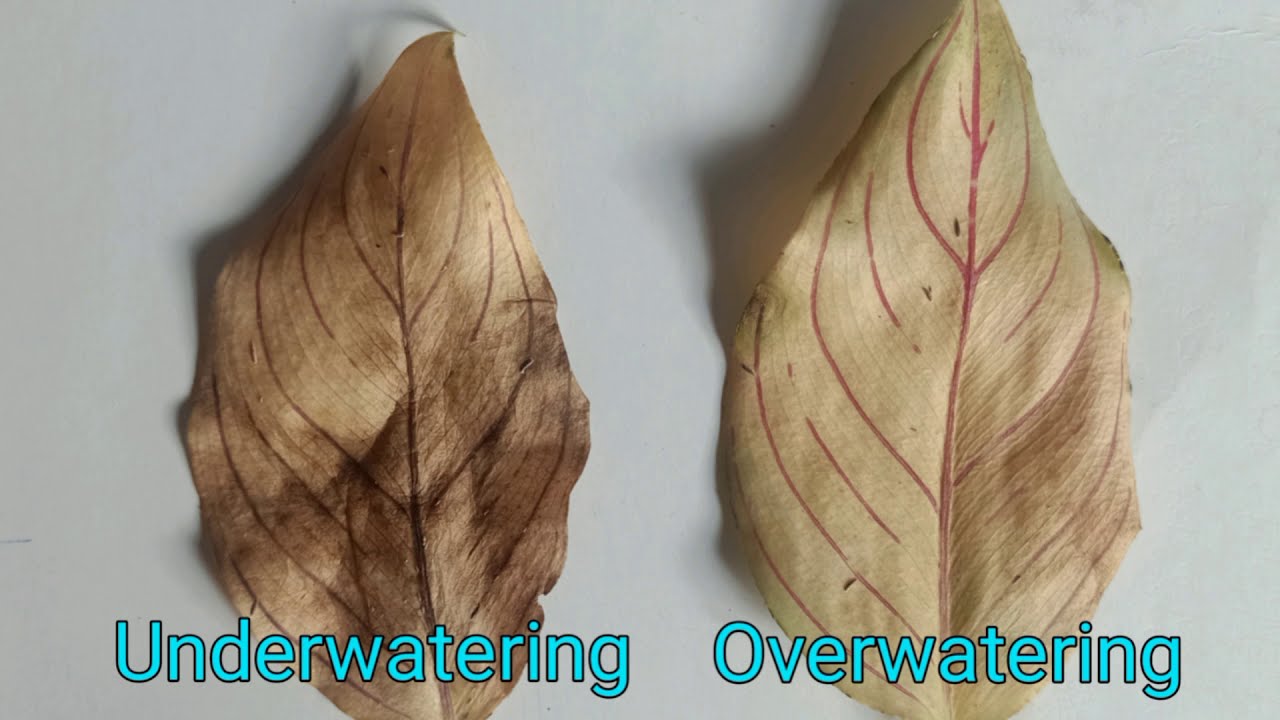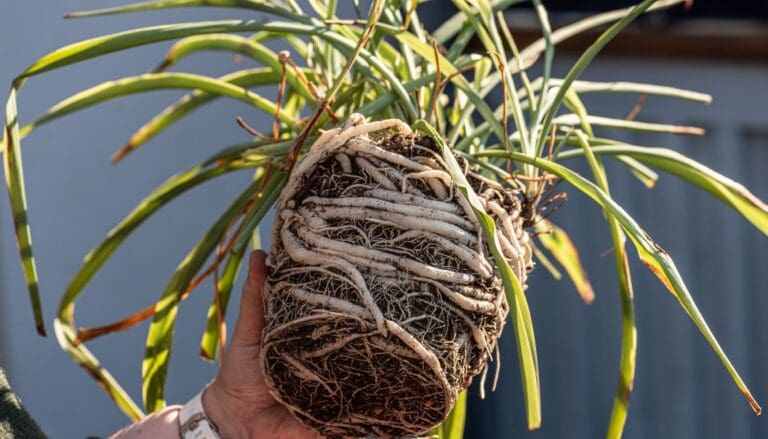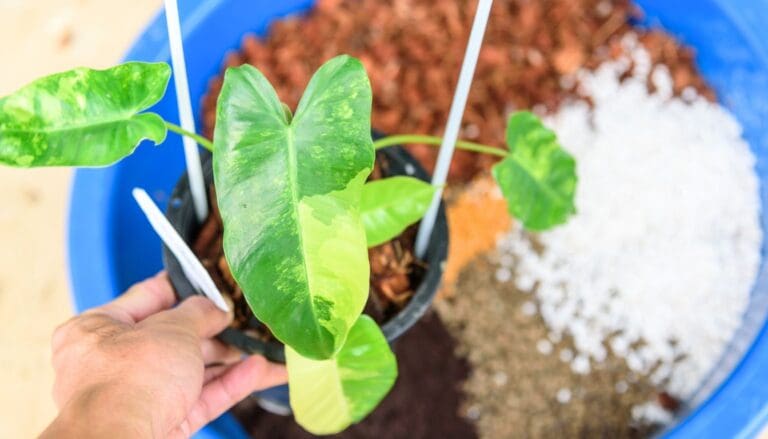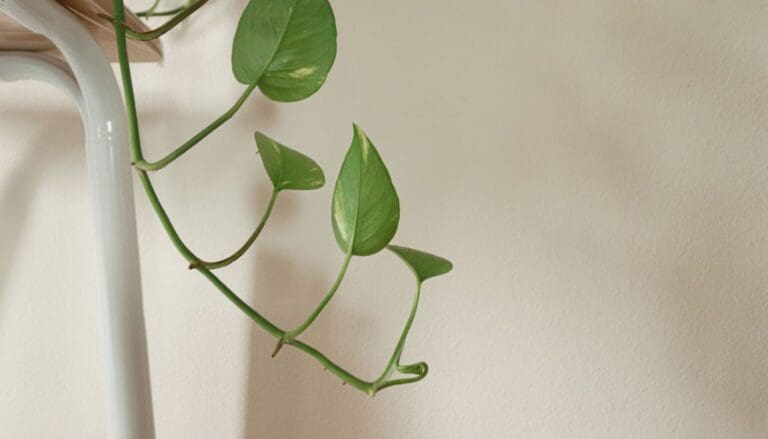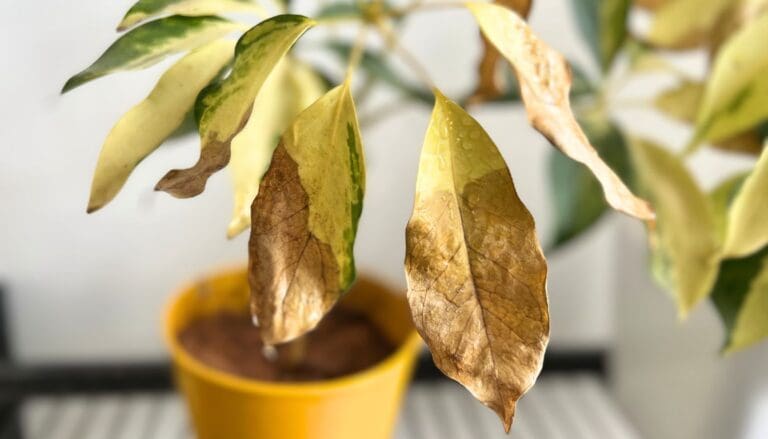Overwatered Philodendron: Signs, Causes & How To Fix!
Fixing an overwatered plant can be a challenge. If we take proper care by watering the plant after understanding its requirements, we can save the plant from overwatering.
In this article, we will dive into the problem caused by overwatering a philodendron plant and how we can fix an overwatered philodendron. Let’s get right into it.
To save an overwatered philodendron, move the plant to a brightly lit spot, prune the damaged roots and foliage, and check the pot’s drainage hole. If you are using a heavy soil mix, then repot the plant using a fresh, well-draining soil mix and water only when the soil gets dry.
One of the common problems in overwatering is root rot. It isn’t easy to identify the problem in the beginning. But if you notice the early signs, then you must take steps immediately to save your plant.
Now, let’s discuss the problems of overwatering and its fixation.
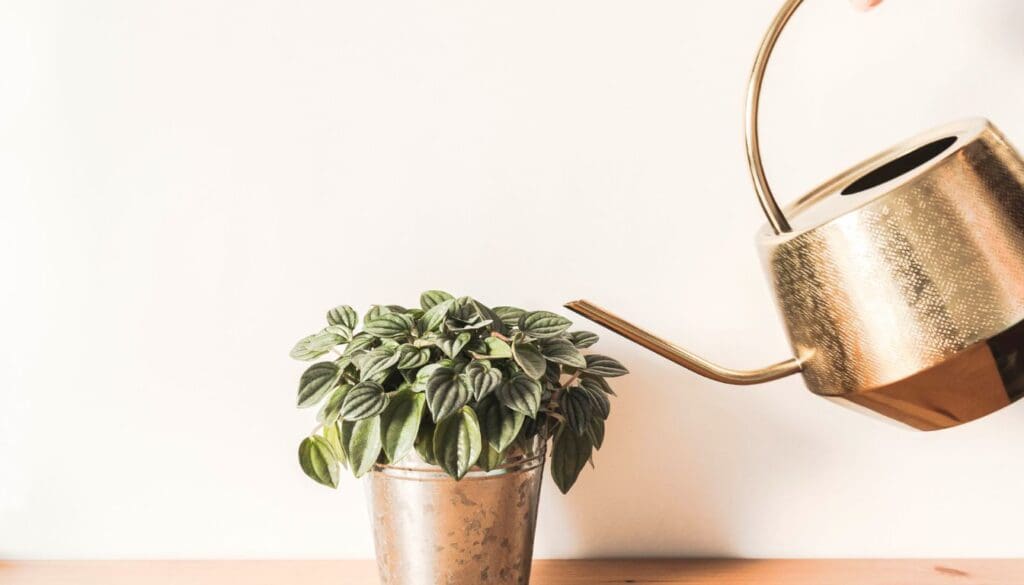
Please note: Simplify Plants is reader-supported. Some links in the post are affiliate links and I get a commission from purchases made through links in the post.
Overwatering a philodendron
Some of you may think that watering your plants frequently will help your plants grow well and fast. No! That is not the case. Watering frequently can only lead to overwatering your plants, ultimately causing root rot.
Philodendrons are native to tropical rainforests. So, it is natural to think that philodendrons need frequent watering. Well, that’s not the case. Philodendrons love a warm environment along with thorough watering.
Another reason for overwatering can be the wrong size of the pot. The size of the pot must rely upon the size of your plant. If the pot is too big and there is no proper drainage system, that can cause overwatering.
Suppose you notice signs of overwatering in your philodendron despite watering it appropriately. In that case, you must check the pot, drainage system, holes, and soil to understand if they are creating any problems.
Also read: What Happens If You Put A Plant in A Pot Too Big?
What does an overwatered philodendron look like?
It is pretty challenging to identify the signs of overwatering in your plant at the beginning. You will find some kind of spots on the leaves of your plant, like white, yellow, or brown spots. The growth of the plant will also seem weak and stunted.
Also, overwatering can lead to root rot. You will get a foul odor from the soil of your plant if the roots are rotting.
Due to root rot, your plant will be vulnerable to pests and all sorts of fungi and bacterial infections. You can see them on the leaves, stems, or over the soil. These fungi, pests, and bacteria can nearly kill your philodendron plant.
You will identify it when the leaves start turning yellow and pale. The leaves will eventually start falling. You can even see early signs of overwatering if you are lucky enough.
How do we differentiate between an overwatered and underwatered philodendron?
Sometimes, it can be challenging to identify whether the plant is overwatered or underwatered. Let’s find out how it can be identified.
If you notice that the stem of your plant near the soil has become mushy and turned brown, then it may be because of overwatering. On the other hand, if the soil is too dry and a bit hard, it is probably due to underwatering.
If you notice that the leaves of your philodendron are becoming flaccid and turning pale green or yellow, then the possible reason is overwatering. If they turn twisted, dry, and crisp, then it is due to underwatering.
Both overwatering and underwatering have one common sign: brown color on the edges of the leaves or brown spots on the leaf’s surface. When the plant is overwatered, you will see brown spots over the surface of the leaves and often brown edges on the leaves. In underwatered conditions, the tips of the leaves will turn crisp and will develop dry brown spots.
The easy way to identify the difference is by observing the condition of the leaves of your philodendron. If they appear as soaked droopy leaves, it is probably due to overwatering. And if the leaves turn dry, twisted, and crisp, it’s due to an underwatered plant.
Also read: Overwatering Vs. Underwatering Plants: Signs, Fix & More.
Signs of identifying overwatered philodendrons
Let’s see how an overwatered philodendron is identified.
Yellow leaves
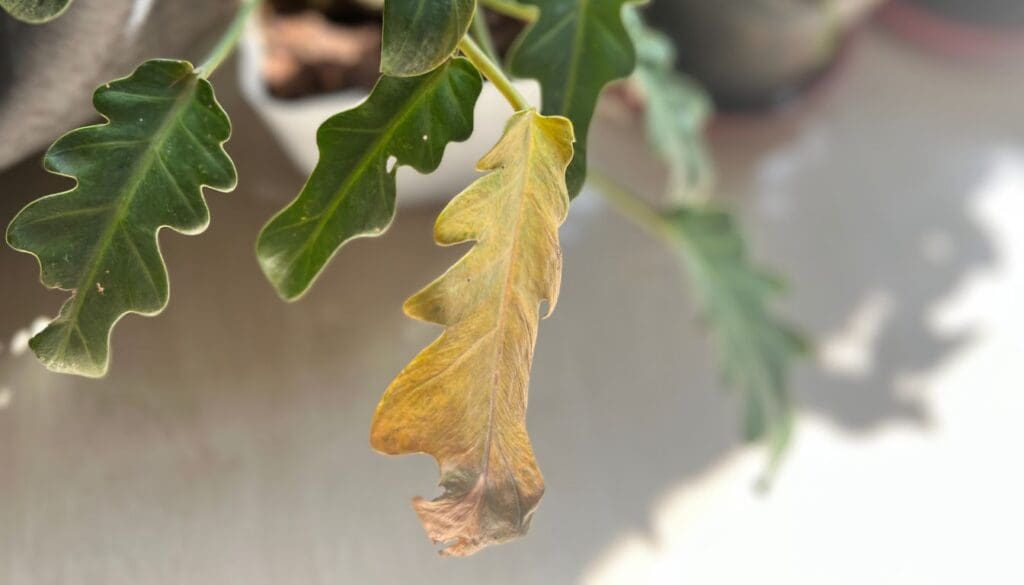
Continuous overwatering can suffocate the roots, and thus the roots will not be able to function correctly.
Failure of root functioning will lead to failure to absorb the essential nutrients and moisture that the plant needs. This can make the leaves yellow. It will start getting yellow from the lower part and will slowly spread all over the leaf.
Also read: Why Is My Philodendron Turning Yellow? (Causes+How To Fix)
Droopy leaves
Droopy and wilted leaves are common both in the case of overwatering and underwatering. In underwatering, watering the plant properly will help the affected plant to recover from dying.
In overwatering, droopy and wilted leaves mean that your philodendron has been exposed to water for a long time, and thus the roots have stopped working correctly. The plant becomes incapable of consuming adequate moisture and nutrients.
Along with wilting, the leaves also turn yellow and brown.
Also read: Why Is My Philodendron Drooping? (Causes+How To Fix)
Brown spots on the philodendron leaves
It is easy to identify the overwatering problem when you see large brown spots on the top of your philodendron leaves.
In the beginning, you will notice that the spots are smaller in size. Eventually, the spots increase in size and slowly spread to other unaffected leaves, affecting different parts of the plant. So whenever you see such spots, prune the affected leaves with disinfected scissors.
You will also see that the edges and tips of the leaves have turned brown due to overwatering.
Also read: Why Is My Philodendron Turning Brown? (Causes+How To Fix)
Falling leaves
The leaves that get affected by overwatering change color. They turn yellow and pale. And ultimately, the leaves start falling off.
You need to get rid of these leaves as soon as possible, or else it will affect other leaves, and slowly, all the leaves will start falling off.
Also read: Why Are My Philodendron Leaves Falling Off? (Causes+How To Fix)
Mushy leaves

Another sign of the overwatered philodendron is the soft and mushy appearance of the leaves. The plant will also appear very weak.
When you overwater your plant, excess water damages the roots and other tissues, which can cause root rot, and this can damage the whole plant.
Appearance of mold
A wet and moist environment has always been favorable for the development of molds. You will generally see them in the soil.
When the soil of your philodendron plant is too moist and wet due to overwatering, the growth of molds will increase gradually, thus damaging the whole plant.
It will also invite pests and fungal infections that can harm your philodendron.
How to fix an overwatered philodendron?
Overwatering can be found in different stages. If you notice that your philodendron is overwatered in the initial stages, you can save it from root rot by taking specific steps. In the later stages, you’ll need to repot the plant to save it from root rot.
It can depend a lot on how hardy your plant is, the type of damage caused due to the overwatering, and how you treat it. Any damage caused during the treatment can make the situation worse.
Now let’s check how you can fix your overwatered philodendron.
If the overwatering is mild, you can follow these steps to fix the issue.
- Tilt the pot to get the standing water out of the pot.
- Let the pot and the soil get dry entirely by placing it in an area with good airflow and indirect light.
- Ensure that light is not too intense or bright, as the plant is already stressed due to overwatering. Too much light can add to the stress.
- Empty the tray beneath the pot.
- Avoid fertilizing till the plant recovers. Adding fertilizer can stress the plant even more.
- Place the philodendron a few feet away from any heating source that will let the excess water evaporate. Make sure you don’t overdo it.
- Try to keep the humidity low. Yes, philodendrons require high humidity, but you don’t need to keep the humidity high for an overwatered plant. You can use the humidifier again after the plant recovers.
- Ensure that the air circulation is good but don’t expose the plant to hot or cold drafts.
If your philodendron has started showing signs of overwatering, such as yellow leaves or brown tips, the steps mentioned above will not be enough.
- You need to get rid of the foliage that is turning yellow or brown. Also, pruning some foliage will reduce the stress of the plant.
- Do not fertilize your philodendron. You can fertilize it after you notice new growth.
- If the soil is not drying and still holds water, take the plant out of the pot, spread the soil and roots on paper, and let it dry.
- If you don’t want to do this, you can poke the soil with a stick to get some air through the holes that will help it get dry. However, be careful as you don’t want to damage the roots.
- Never try to squeeze the roots to get the water out of them, as it can damage the roots and the plant.
- You can use a fan to increase the airflow so that the water can dry fast.
- Try to decrease the humidity by using a dehumidifier.
- Check the potting soil and add perlite or pumice to it to make it well-draining.
- Remove the old soil from the roots gently. Don’t be harsh, as that can damage the roots.
Root rot
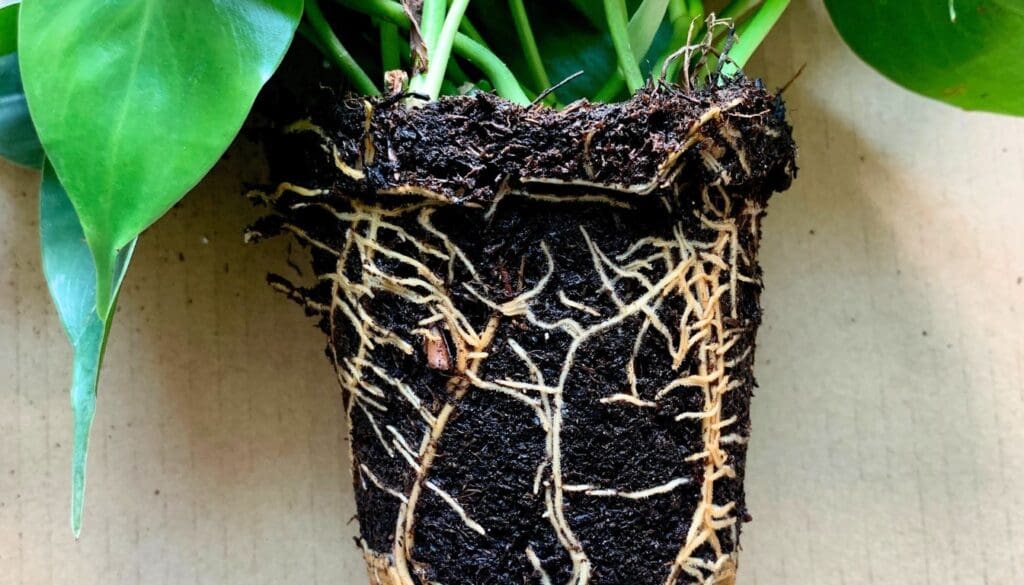
Root rot is one of the apparent signs of overwatering.
It happens when the roots get destroyed due to staying in the water for too long, due to which they absorb excess water and suffocate themselves.
Root rot is one of the primary problems caused due to overwatering.
Philodendron being a tropical plant, will not like the damp soil. If you keep overwatering any plant for an extended period, the roots fail to function further and become weak due to excess water absorption.
When the roots of your philodendron stop working correctly, the plant won’t absorb enough moisture and nutrients needed for proper growth.
When there is root rot, you will get a foul odor from your plant. They will become brown and turn mushy. This is what we call root rot.
Also read: How Do You Fix Root Rot On A Philodendron? (Signs, Causes+Solution)
Signs of root rot
How do you know if your philodendron is having the problem of root rot? Let’s find out.
- Yellow leaves
- Soft mushy leaves
- Soft stems
- Brown spots
- Foul odor from the soil
- Stinky roots
- Brown roots
How can you save your philodendron from root rot?
To save your philodendron from severe root rot, you need to follow specific steps.
First, stop overwatering your plant. If you have already overwatered your plant, then stop watering it. Too much water will weaken the roots, and the plant will not be able to absorb the required moisture and nutrients. Then, shift your plant to a bright light so that the soil can get dry.
You may see that some of the leaves have turned yellow and pale. You’ll even see brown spots on the leaf tops and edges. These are signs of overwatering. You need to remove the affected leaves; otherwise, it will spread slowly to all the other leaves and finally affect the whole plant.
If you see any sign of root rot, you quickly need to get rid of those damaged roots. For that, you have to take out the whole philodendron from its pot. You can use a knife to make the process easy and quick. After that, cut off the damaged roots from the plant.
You can also cut off the affected stems from the plant, that is, the very soft and mushy stems.
If the root rot is extreme, it would be better to repot your philodendron after pruning the affected parts.
For repotting, you will need a new pot. Make sure that the new pot has proper drainage holes. You can also wash the old pot nicely and use it.
Use fresh soil. Don’t use the old soil, as they may get affected by fungus and bacteria due to root rot. Use a fresh mix of peat-based soil and perlite, put them in the new pot, and then plant your philodendron. You can use neem oil to stop the plant from being attacked by any different pests or fungi.
Place your pot in a bright place where the plant gets indirect sunlight. Avoid direct sunlight, as it will cause sunburn. Also, skip using fertilizers for some time until your plant recovers from the damage.
Also read: Where Do You Put A Philodendron? (Ideal Spot+Factors To Consider)
Propagation

If the overwatering has reached an extreme level, it can be pretty difficult to save the plant. At this point, propagating the plant is a good idea.
If a few leaves or stems are still in good condition, you can use them for propagation. You must cut a long vine or stem of about 3-4 inches with nodes and a few leaves on them. Then insert them into the soil in a container or a water-filled jar.
Water the cuttings and cover them with plastic to maintain proper humidity. Once the roots start coming out, shift the plant from a container or jar to a pot filled with fresh soil mixture. You can also let the plant grow in water by keeping it in a glass jar.
Also read: How To Propagate Philodendron? (Soil And Water Propagation)
How to avoid overwatering the philodendron?
To avoid overwatering your philodendron, you need to keep some points in mind:
- Water your philodendron once the soil dries up and is ready for further watering.
- You must keep an eye on the drainage system of the plant.
- Use proper soil mix for your plant allowing proper drainage.
- Check the moistness of the soil.
- Maintain proper watering techniques based on the seasons. Water frequently during its favorable season and waterless during winters.
- Also, maintain the watering based on the placement of your plant. If your philodendron is placed in a bright area, give it more water, whereas give it less water when placed in low light.
Sometimes, philodendrons reach an extreme level of damage, and it can be next to impossible to revive your plant. But as philodendrons are hardy plants, if you follow proper procedures to bring them back to life, they won’t disappoint you and will have a much better comeback and continue to thrive.
Ref: Wikipedia.
Recommended Garden Supplies
| Product Image | Our Recommended Gardening Supplies | Check Offers! |
|---|---|---|
Top Top
Top
Top
Top
Top
Top
Top
Top | rePotme Houseplant and Tropical Classic Potting Soil Mix | Check Offer On Amazon |
 Top
Top
Top
Top
Top
Top
Top
Top | Espoma Organic Indoor Plant Food | Check Offer On Amazon |
 Top
Top
Top
Top
Top
Top
Top
Top | GooingTop LED Grow Light 6000K Full Spectrum Clip Plant Growing Lamp | Check Offer On Amazon |
 Top
Top
Top
Top
Top
Top
Top
Top | Soil Moisture Meter | Check Offer On Amazon |
 Top
Top
Top
Top
Top
Top
Top
Top | Govee Hygrometer Thermometer, Bluetooth Enabled! | Check Offer On Amazon |
 Top
Top | LEVOIT Humidifiers for Large Room(Best For Plants) | Check Offer On Amazon |
 Top
Top
Top
Top
Top
Top
Top
Top | Upgraded DIY Automatic Drip Irrigation Kit, 15 Potted Houseplants Support | Check Offer On Amazon |
 Top
Top
Top
Top
Top
Top
Top
Top | Stainless Steel Heavy Duty Gardening Tool Set | Check Offer On Amazon |
 Top
Top
Top
Top
Top
Top
Top
Top | Bonide Insecticidal Soap | Check Offer On Amazon |
 Top
Top
Top
Top
Top
Top
Top
Top | Bonide 32 oz Spray Neem Oil for Organic Gardening | Check Offer On Amazon |
 Top
Top
Top
Top
Top
Top
Top
Top | Garden Safe Fungicide | Check Offer On Amazon |

